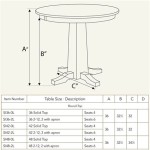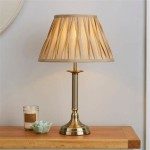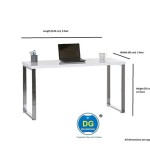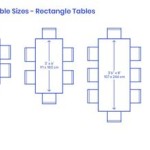How To Remove Deep Scratches From a Wood Table
Deep scratches on a wood table can be unsightly, diminishing the aesthetic appeal and potentially affecting the value of the furniture. While minor surface blemishes often disappear with standard cleaning and polishing, deeper scratches require a more comprehensive approach to repair. This article provides a detailed guide on addressing deep scratches in wood tables, outlining the necessary materials, techniques, and considerations for achieving a satisfactory restoration.
Before commencing any repair, it is crucial to assess the severity of the damage and the type of finish applied to the wood. Different types of finishes, such as varnish, lacquer, polyurethane, or oil-based finishes, respond differently to various repair methods. Improper techniques can exacerbate the damage, leading to further complications and potentially requiring professional refinishing.
The following steps outline a comprehensive process for effectively removing deep scratches from a wood table, aiming to restore its original appearance and protect the underlying wood.
Key Point 1: Preparation and Assessment
The initial stage involves meticulously preparing the work area and thoroughly assessing the scratch. This ensures a clean environment and provides a clear understanding of the damage extent.
First, clear the table of any objects and thoroughly clean the surface with a mild soap and water solution. This removes dirt, dust, and debris that could interfere with the repair process. Allow the table to dry completely before proceeding. A clean surface ensures better adhesion for any filling materials or finishes used during the repair. Using a soft cloth, gently wipe the area around the scratch to avoid further abrasion.
Inspect the scratch carefully under good lighting. Determine its depth, width, and direction. Identify the type of finish on the table. This can often be determined by observing how the finish reacts to certain solvents. For instance, lacquer finishes tend to dissolve when exposed to lacquer thinner, while polyurethane finishes are more resistant. If the finish is unknown, it's best to test a small, inconspicuous area with different solvents to avoid damaging the table. Taking clear photographs of the scratch before starting can be helpful for comparing the "before" and "after" results.
Gather all necessary materials before beginning the repair. This typically includes:
- Fine-grit sandpaper (220-grit, 320-grit, and 400-grit)
- Wood filler or wood putty
- Putty knife or palette knife
- Color-matching stain or paint
- Clear finish compatible with the existing finish (e.g., varnish, lacquer, polyurethane)
- Clean cloths
- Tack cloth
- Mineral spirits or appropriate solvent for cleaning
- Safety glasses
- Dust mask
- Gloves
Having all these materials readily available will streamline the repair process and minimize interruptions.
Key Point 2: Filling the Scratch
Once the table is prepared and the materials are gathered, the next step involves filling the scratch with an appropriate wood filler or putty. This provides a solid base for subsequent sanding and finishing.
Select a wood filler or putty that closely matches the color of the wood. If an exact match is not available, choose a shade slightly lighter than the wood, as it can be tinted later. Using a putty knife or palette knife, carefully apply the filler into the scratch. Press firmly to ensure that the filler completely fills the void and adheres properly to the surrounding wood. Avoid applying excessive amounts of filler, as this will require more extensive sanding later.
Overfill the scratch slightly, allowing the filler to protrude slightly above the surface of the table. This compensates for any shrinkage that may occur as the filler dries. Allow the filler to dry completely according to the manufacturer's instructions. Drying times can vary depending on the type of filler used and the ambient humidity. It's crucial to allow sufficient drying time to prevent the filler from sinking or cracking later on.
After the filler is completely dry, use fine-grit sandpaper (220-grit or 320-grit) to carefully sand down the excess filler, level with the surrounding surface. Use a sanding block to ensure even pressure and avoid creating dips or indentations in the wood. Sand in the direction of the wood grain to minimize the appearance of scratches left by the sandpaper. Periodically check the surface with your fingers to feel for any unevenness. If necessary, switch to a finer grit sandpaper (400-grit) to achieve a smooth, seamless transition between the filler and the surrounding wood.
Once the surface is smooth and level, remove any sanding dust with a tack cloth or a slightly damp cloth. Ensure the surface is completely clean and dry before proceeding to the next step.
Key Point 3: Staining and Finishing
After filling and sanding the scratch, the next stage involves staining and finishing the repaired area to match the existing finish of the table. This step requires careful attention to detail and color matching to achieve a seamless and professional-looking repair.
If the wood filler is a different color than the surrounding wood, it will need to be stained to match. Carefully select a wood stain that closely matches the original color of the table. Test the stain on a scrap piece of wood or an inconspicuous area of the table to ensure an accurate color match. Apply the stain to the filled area using a small brush or a clean cloth. Apply thin, even coats of stain, allowing each coat to dry completely before applying the next.
Use a clean cloth to wipe off any excess stain, blending the edges of the stained area with the surrounding wood. This helps to create a seamless transition and prevent the stained area from appearing too dark or blotchy. Allow the stain to dry completely according to the manufacturer's instructions. Drying times can vary depending on the type of stain used and the ambient humidity.
Once the stain is dry, apply a clear finish to protect the stained area and blend it with the existing finish of the table. Select a clear finish that is compatible with the original finish of the table. For example, if the table has a polyurethane finish, use a polyurethane clear coat. Apply the clear finish in thin, even coats using a brush, a spray gun, or a clean cloth. Allow each coat to dry completely before applying the next. Lightly sand between coats with very fine-grit sandpaper (400-grit or higher) to remove any imperfections and create a smooth, even surface. Remove all sanding dust with a tack cloth before applying the final coat of finish.
Apply the final coat of clear finish and allow it to dry completely according to the manufacturer's instructions. Avoid touching or handling the repaired area until the finish is completely dry and cured. Once the finish is fully cured, the repaired area should blend seamlessly with the surrounding wood, effectively concealing the deep scratch.
In cases where the scratch is particularly deep or the finish is severely damaged, it may be necessary to apply multiple coats of clear finish to achieve a smooth, even surface. Patience and careful attention to detail are essential for achieving a professional-looking repair.
After the final coat of finish has dried, inspect the repaired area carefully under good lighting. If necessary, use a fine-grit polishing compound to buff the surface and remove any minor imperfections. Apply a furniture polish to enhance the shine and protect the repaired area. Regularly clean and maintain the table to prevent future scratches and damage.
If the above steps do not produce satisfactory results, or if you are uncomfortable performing the repair yourself, it is advisable to seek professional assistance from a furniture repair specialist. A professional has the expertise and tools to address more complex repairs and restore the table to its original condition.

5 Easy Ways To Fix Scratched Furniture

Get Scratches Out Of Wood Practical Diy Advice New England

Tested 5 Ways To Remove Scratches From Wood Furniture A Erfly House

3 Simple Ways To Fix Deep Scratches In Wood Wikihow
How To Fix Deep Scratches In Wood Frugally

6 Ways To Remove Scratches From Your Table Grain Frame

3 Simple Ways To Fix Deep Scratches In Wood Wikihow

Repairing Scratches On A Table Top

Tested 5 Ways To Remove Scratches From Wood Furniture A Erfly House

How To Fix Scratches In Your Wood Table








